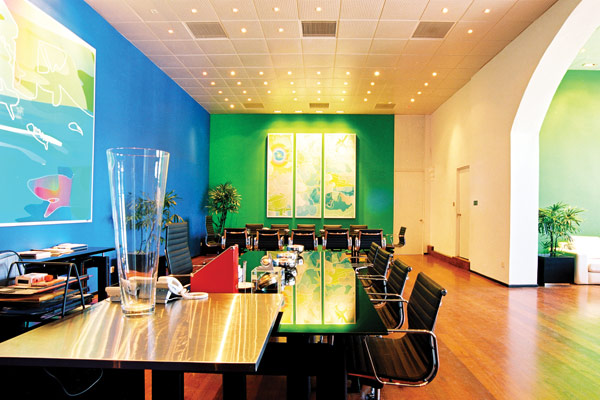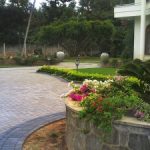-
“A Dance with Space”
July 2010
By Prasadini Nanayakkara | Photography by Eresh Weerasuriya
The building presently housing the Ports and Aviation Ministry Offices was a listed 19th Century British Colonial Building of the Edwardian era. It was known as the “Custom House Building” and had undergone several stages of refurbishing and was in a severely dilapidated condition. In order to serve its present purpose Archt Nela De Zoysa took on the task of first restoring the building and thereafter wholly refurbishing its interior complete with modern amenities to serve the Ministry’s functions and restore the heritage building to its former glory.

The building’s interior consisted of archaic panelling, mineral board partitions and heavy furnishings. “We stripped the entire interior down” says Archt Nela De Zoysa. The building first required restoration, which incurred a cost three times that of the interior refurbishment. The stripping of the interior revealed arches, columns and Burma teak flooring. “As an architectural conservationist it was my priority to first restore the building which I discovered had been built in three stages,” says the architect adding that as a listed heritage building its façade had to remain untouched. “The stripped interior offered a beautiful expanse of space, you could have a dance with space and this is what influenced me,” says Archt De Zoysa on proceeding with the interior of the building.
The building’s location in a high security zone with one side of the building overlooking the garden of the President’s House posed several challenges. The old windows required restoration and some had been nailed shut for security reasons. These were reopened and the panes substituted with mirrors to prevent visibility to the outside. This also added another dimension to the space in the interior of the building. Furthermore soundproofing was required in several areas of the building.
The interior was designed using modern material including glass and stainless steel to create a contemporary atmosphere that contrasted largely with the exterior of the building. “The contrast between the classical and the contemporary shocks you,” states the Architect adding that, “to change its use is a way to conserve a building, a building cannot be preserved by letting it stand.” The ground floor which originally housed old British colonial garages was rebuilt and extended for use as a public waiting area and accommodate guest relations officers, coordinators, security and amenities for the staff of the floor. This floor accommodated a separate entrance for the constituents. Towards the interior, the reception hall was kept completely white. Here a series of panels were installed with light that carried gradations of blue tones to create the effect of the sea. This, the Architect intended so as to keep with the theme of sea and sky suited for the Ports and Aviation Ministry.
A restored, cut and polished, grand Burma teak staircase of the colonial period leads up to the lobby of the first floor. This floor houses the conference room, offices for the Minister, Public Relations, Media Consultant and Coordinating Officers. “The windows, columns and beams influenced the divisions of space and I didn’t go against what was originally there,” says Archt De Zoysa. “Some of the rooms were fairly large since I avoided partitioning in the middle of a window which had been done previously,” she further adds. Kirby de Lanerolle’s graphic art panels of a container yard that soar to a height of 15-20 ft were installed in the aforementioned offices. Glass doors of the rooms allowed the visibility of these images when walking through the passageway to permeate the theme of Port and Aviation. However, use of glass was limited in the conference room in order to avoid glare. Here, a series of high panels of vivid colour were installed. These colour panels and images were designed to great heights as they could be accommodated in the spaces where the ceilings were exposed to its highest point during the building’s restoration.
Another stairway was uncovered and restored and served as a separate entrance to the Minister’s office. This office and the VIP lounge were of vibrant green and robin blue hues with white and stainless steel leather upholstered contemporary furniture to contrast with the Burma teak flooring. The remainder of the floor area was laid with white tile to provide a minimalist look. The VIP lounge and the Minister’s office were also adorned with large sized digital artwork that graphically represents the functions of the ministry. These include images such as a propeller, anchor and a ship. The first floor also accommodates offices for the support staff and other amenities. “I am proud to say that all the finishes were done using local materials and products, nothing was imported except for the office chairs. Even the lounge and lobby chairs were done locally and being mindful of using public funds, cost constraints were controlled with the use artificial leather which is more user friendly,” explains the Architect.
While from its exterior this building remains distinctly colonial in appearance its interior of wooden floors, arches, columns and stairways merges with the new to be showcased in highly contemporary light. “I have a deep interest in the subject which is why I took a great interest in its restoration,” says Archt Nela De Zoysa. “Then again I am a contemporary architect, I love contemporary work using modern material and hence enjoyed doing this project immensely,” she concluded. Completed in a period of ten months the Ports and Aviation Ministry Building was nominated for an SLIA award in 2007.
Principal Architect/ Project Architect: Archt. Nela de Zoysa
Assisted by Pushpa Jayasekera: Architectural Licentiate
Architectural firm: Nela De Zoysa Design Corporation
Other Consultants:
Structural Consultants: Perigon Lanka
Electrical Engineers: Noel Joeseph
Civil Contractor: Renuka Builders
Furniture: Alpha Industries
Project period: 10 months
Completion: 2005


















